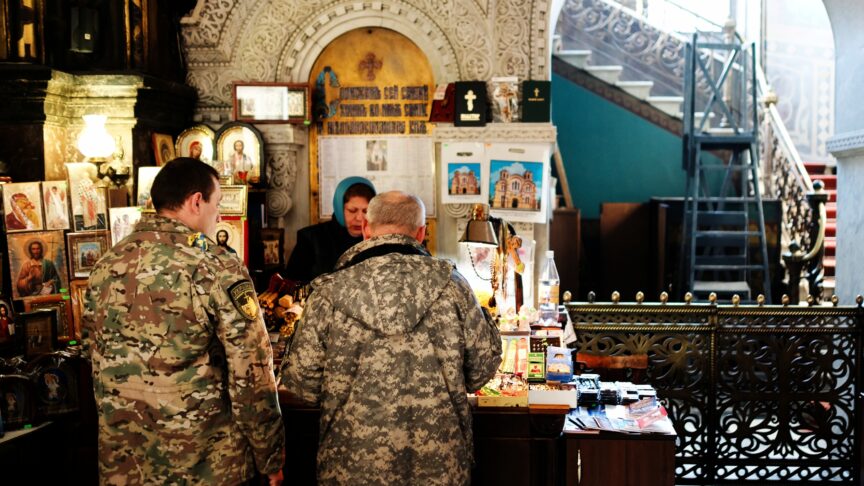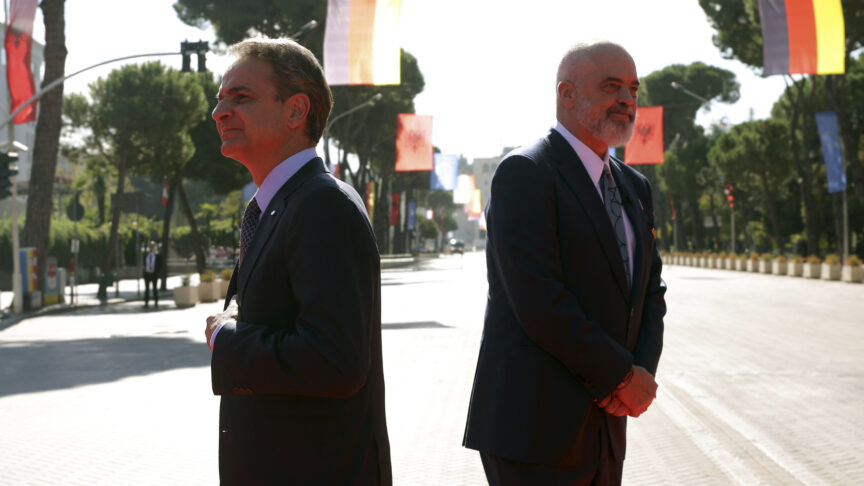Russia, Ukraine, and the Orthodox church: Where religion meets geopolitics and war
In Ukraine and North Macedonia, the Orthodox Church is facing deep, even violent, splits, on the one hand; and is edging closer to resolving decades-old disputes, on the other
The Russian Orthodox Church has played a crucial supporting role in the rule of Vladimir Putin. And, with research suggesting a strong association in the Orthodox world between people’s religion and their national identity, church affairs hold particular importance for temporal leaders. This is whether they are, in the case of Ukraine, seeking to defend against an external aggressor; or, in North Macedonia, looking to complete state-building business with legacies left over from Yugoslavia. Recent developments in each country reflect the political divides in eastern Europe, with one sinking into deeper, violent, division and the other on the verge of resolution.
The Russian Orthodox Church – whose leader, Patriarch Kirill, the European Union recently sought to sanction – is the largest and richest church within Eastern Orthodoxy. The worldwide church is headed by Ecumenical Patriarch Bartholomew, with whom the Russian Orthodox Church broke in 2018 over the issue of the autocephaly (self-government) of the then newly formed Orthodox Church of Ukraine, whose autocephaly Bartholomew had granted. Now, following Russia’s invasion of Ukraine, ordinary Ukrainians seem to be rapidly turning away from the Russian Orthodox Church – which still has many churches in the country in the form (since 1990) of the Ukrainian Orthodox Church-Moscow Patriarchate (UOC-MP). The UOC-MP is part of the broader Russian church but has a measure of self-government. Meanwhile, another crucial decision by Bartholomew has seen him broker a solution to a seemingly intractable dispute, namely: persuading the Serbian Orthodox Church (traditionally backed by Russia) to accept the full independence of what will now be known as the Macedonian Orthodox Church-Archdiocese of Ohrid.
Ukraine
The UOC-MP has long retained an important presence in Ukraine, making up one-third of all the parishes of the Russian Orthodox Church. The UOC-MP dislikes the ‘Moscow Patriarchate’ tag, arguing that it is based in Ukraine. But it has long resisted pressure from the Ukraine side to adopt autocephaly, most notably at the same Sobor (bishops’ council) of the Russian Orthodox Church in 2000 that canonised Nicholas II and his family.
In Ukraine, the two principal rival churches have diverged over time, in three phases, the first of which began in 2014. The Maidan Revolution in February that year began the process towards creating the Orthodox Church of Ukraine. Amid the wider geopolitical tensions, that July the UOC-MP saw the death of its relatively ecumenical patriarch, Volodymyr, and his replacement by the more radical Onufrii, a strong supporter of Putin’s re-imperialising ‘Russian World’ doctrine.
The second phase began in 2018 with a campaign by Russia to strangle the Orthodox Church of Ukraine at birth. Bartholomew provided a formal letter (or ‘Tomos’) of approval of the church’s autocephaly on Orthodox Christmas Day in January 2019. The Kremlin, the Russian Orthodox Church, and Orthodox oligarchs pressured the other Orthodox churches not to recognise this. As of mid-2022, only the churches of Greece, Cyprus, and Alexandria and All Africa have recognised the Orthodox Church of Ukraine. When the Russian Orthodox Church broke with Bartholomew, it dubbed him a US puppet and described his mere “Istanbul Patriarchate”. It campaigned to reverse the decision and undermine his authority, and even set up two new dioceses in Africa to poach off the Alexandrian church.
If Russia were to prevail, the Orthodox Church of Ukraine would be suppressed, with parishes transferred directly to the Russian Orthodox Church
The third phase – Russia’s current war on Ukraine – raises the stakes much higher. If Russia were to prevail, the Orthodox Church of Ukraine would be suppressed, with parishes transferred directly to the Russian Orthodox Church, as is already happening in occupied territories. Kirill has echoed Putin’s language of Ukrainian-Russian “unity” on Russian terms and endorsed the war against “evil forces”, even comparing it to a metaphysical struggle against gay pride parades. On 12 May the UOC-MP issued a statement saying that religious policy in Ukraine was “one of the reasons for the military invasion of Ukraine”.
In the event of Ukrainian victory, or even just survival, the UOC-MP will come under strong pressure to cut its ties with Russia and negotiate a modus vivendi with the Orthodox Church of Ukraine. However, 400 UOC-MP priests have appealed against what they term Kirill’s “heresy,” and more than 400 parishes have left the UOC-MP since the invasion began. To forestall further radical moves, the UOC-MP has lately become more critical of the war. On 27 May, a special Sobor “condemn[ed] war as a violation of God’s commandment ‘Thou shalt not kill!’” In a minimal formulation, it “expresse[d] condolences to all those who suffered in the war”,” without explicitly blaming Russia. More clearly, the church formally “disagree[d] with the position of Patriarch Kirill of Moscow and All Rus’ on the war”. The Sobor also declared “independence”, although not full autocephaly.
Ukrainian critics thought this move did not make the UOC-MP independent enough; that it was window-dressing, or “little rain from a large cloud”. The Russian parent church thought it made them too independent: on 7 June it retaliated by annexing all three dioceses in Crimea to create a Metropolitanate of Crimea. This is the second such takeover: a multi-ethnic Metropolitanate of Gothia existed until the departure of Crimean Christians in 1778, some of whom founded Mariupol. The Russian church took over, and a Tavrian Eparchy was established in 1859.
The reasons the UOC-MP has sought to distance itself are not hard to guess. Before the war began in February, 40 per cent of Ukrainian believers in one independent poll backed the Orthodox Church of Ukraine and 20 per cent the UOC-MP. A further 33 per cent called themselves “just Orthodox” But now, the Orthodox Church of Ukraine claims the support of 52 per cent of people, with the figure suggesting “just Orthodox” down to 11 per cent, and followers of the UOC-MP at just 4 per cent. An opinion poll in April showed 74 per cent of Ukrainians wanted the UOC-MP to cut its ties with Russia and 51 per cent wanted it banned.
The future of these churches is tightly bound up with the wider political and security concerns. In March, members of the Ukrainian parliament introduced two bills that could lead to a ban on the UOC-MP. There are also two new laws on collaboration and aiding and abetting an aggressor state that could be applied against the church. The Orthodox Church of Ukraine is targeting key properties currently controlled by the UOC-MP and seeking to establish its own rival monastery at the important Pecherska Lavra. Many see the presence of the UOC-MP at this site – in the heart of Kyiv – as a security threat.
The 2018 solution of having two canonical Orthodox churches in Ukraine seems unlikely to survive the current war. It may not even survive the current phase of the war, as Ukraine presses ahead with derussification on other fronts, including restrictions on Russian books and music in June.
North Macedonia
On 12 June – Pentecost Sunday – North Macedonia’s prime minister, Dimitar Kovacevski, attended the divine liturgy held in St George’s Cathedral of the Ecumenical Patriarchate in Istanbul. Bartholomew presided, celebrating it together with the Archbishop of Ohrid to mark the resolution of the long-running dispute between the Serbian Orthodox Church and the Macedonian Orthodox Church-Archdiocese of Ohrid.
This disagreement stretched back to 1967 when the Macedonian Orthodox Church seceded from the Serbian Orthodox Church. The Macedonian church then spent decades formally in isolation from the rest of the Orthodox world until 19 May this year, when its status of equality with the other Orthodox churches was unblocked by the Serbian church. The decision was also celebrated with the Serbian patriarch, Porfirije, in Belgrade. All this preceded an earlier meeting of the Holy Synod (of the worldwide church) and its recognition of what is termed the Ohrid Archbishopric, which will have jurisdiction only within the boundaries of the state of North Macedonia. The Ecumenical Patriarchate excluded the recognition of the name Macedonia as part of the name of the church, and any other derivate of Macedonia.
Although the conflict between the two churches seems to have been resolved fairly quickly, the process of dialogue was set in motion back in 2018 and was deliberately kept out of the public eye. This was at a time when parallel efforts were in full swing to resolve the name dispute with Greece that had long lingered over what eventually became North Macedonia. The resolution to this problem ultimately unlocked North Macedonia’s path to NATO and potentially the European Union. Zoran Zaev, then the country’s prime minister, together with the church, approached Batholomew to ask him to help end the ecclesiastical isolation. At that time, they hinted that they were open to a name change to “Ohrid”. Bartholomew replied that he was willing to assist and take the initiative to restore the church to the Orthodox canonical framework. This in itself was something of a victory, as until that point Bartholomew had hesitated to get involved and would instead only encourage the Macedonian church to talk to its Serbian counterpart.
Some believers in North Macedonia remain concerned at how other churches, in particular the Bulgarian Orthodox Church, may react
Bartholomew’s decision to welcome the Macedonian church into communion came on 9 May, when he also issued a request for the Serbian church to resolve “administrative issues” with the Macedonian church. Porfirije handed the Tomos to Archbishop Stefan of Ohrid, fully confirming the autocephaly of the Macedonian Orthodox Church-Archdiocese of Ohrid. The Tomos notes that autocephaly must be submitted for approval by other churches within the Orthodox church.
While the Serbian church has moved towards a smooth resolution of what seemed an intractable dispute, some believers in North Macedonia remain concerned at how other churches, in particular the Bulgarian Orthodox Church, may react, considering that Bulgaria has been blocking North Macedonia’s future EU accession by insisting that Macedonian language and identity are of Bulgarian origin. Given that the Byzantine name of the Bulgarian church is “Archdiocese of Ohrid” there are worries that Bulgaria will not accept the name and new requirements may be added to existing ones.
The Russian Orthodox Church has been keeping tabs on this issue: it branded Bartholomew’s decision an “irregular and politically motivated intrusion” and called on other churches not to recognise his authority in the matter. This indicates the long and close relationship between Russia and Serbia in the resolution of such issues. But its tone altered drastically when the Serbian church accepted the change.
Although the cases of Ukraine and North Macedonia are sharply contrasting, each still faces an uncertain future in which the place of their Orthodox churches are entangled in wider disputes with, or aggression from, neighbouring states. The war in Ukraine in particular has exposed and exacerbated deep rifts within the Orthodox world, with even the Russian Orthodox Church apparently splitting as a consequence of the conflict. The remaining presence and role of the churches in Ukraine will reflect the results of the war and provide symbolic meaning to the contested questions of nationhood and independence there.
The European Council on Foreign Relations does not take collective positions. ECFR publications only represent the views of their individual authors.



